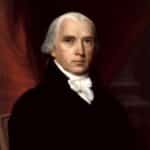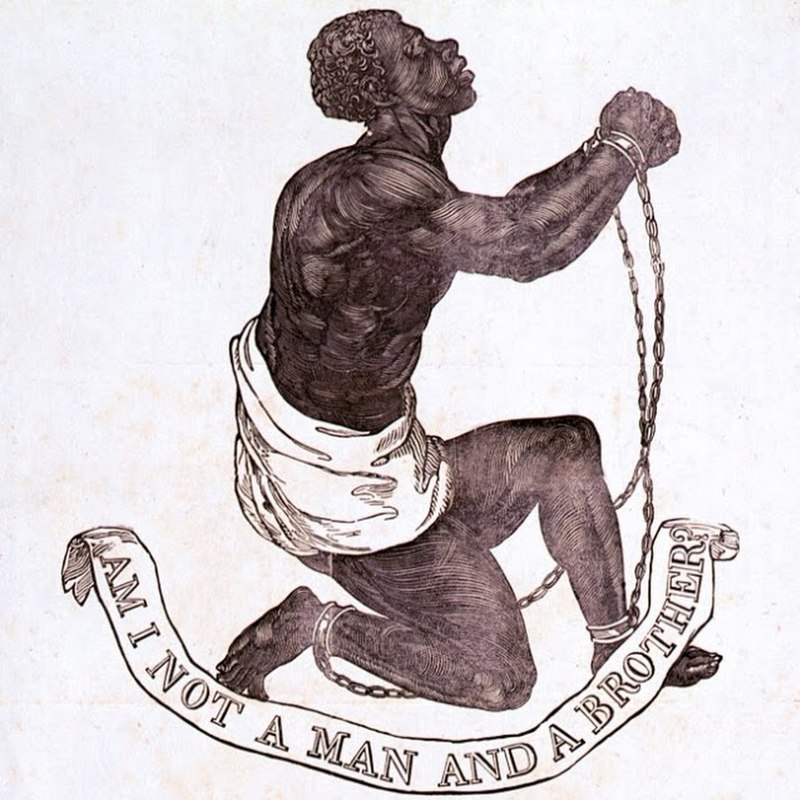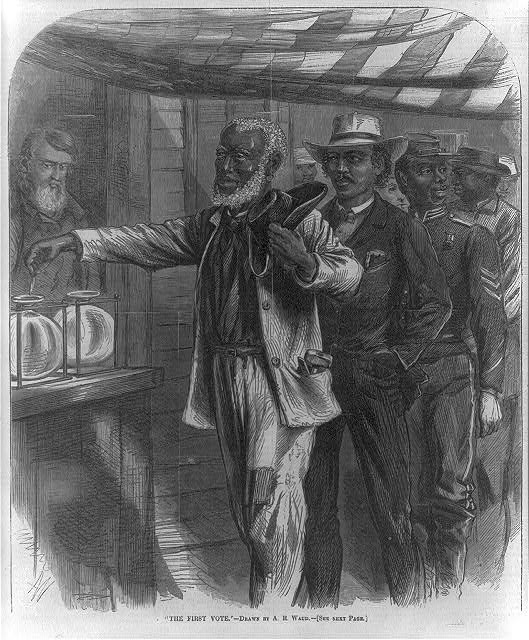The purpose of these “Themes Across APUSH” blog posts is for you to practice the historical thinking skills required for the APUSH exam. Today, you’ll practice the skill of examining patterns of change and continuity over time by looking at one APUSH theme: territorial expansion throughout U.S. history.
As you are reading, you should be thinking about:
- What patterns of continuity and change to you recognize over time?
- How can you connect this theme to other themes across U.S. history?
- What argument would you make about this theme on the APUSH exam?
The goal for these blogs is not to give you an exhaustive view of this topic; believe me, people much smarter than I am have written books and books on the subject. Instead, we want you to be able to think about patterns in U.S. history so that you can organize your own studying efficiently. Ready? Let’s go!
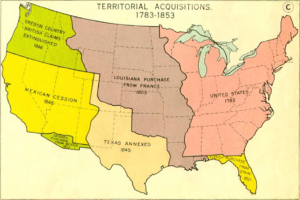
Source: Government Map Created in Mid-20th Century
A Brief Overview: Expansion in U.S. History
The story of U.S. History generally goes east to west; that is, some people (a mix of Europeans and Africans) arrived in the East and headed, slowly but surely, West. The people these Europeans—history textbooks tend to leave out the Africans at this point—encountered as they marched West were generally indigenous people, sometimes different Europeans, but were always considered “Others” that had to be integrated into the America that existed back East.
With this blog post, I hope to disrupt that “east to west” narrative. In order to do that, I will go in depth about one particular type of expansion: that of the original colonies. In this section, I will make connections between the “mainland” colonies and the West Indies/Caribbean colonies and argue that the framework of “middle grounds” or “native grounds” between settlers and indigenous populations can help you make sense of changes and continuities over time.
At the end of the post, I will give you three sample documents to help you make sense of other aspects of territorial expansion in United States history (and one of these is likely to come up in the APUSH exam!). I will highlight some potential ways you could make sense of these documents if you were to write an essay that had to attend to changes as well as continuities over time.
Of course, this story I am presenting leaves out quite a bit. But think, as you continue to read, how the story might change if you added, say, the annexation of Texas or the Floridas to this story. In essence, by leaving out some types of territorial expansion, I am hoping that you will continue the process of thinking about change and continuity over time in U.S. history.
APUSH Themes: Expansion and the Original Colonies
At this point, it’s not news to you that the thirteen “original” colonies had disparate ideologies and charters. Many wonderful historians have done the work of demonstrating how improbable a “United” anything was at the eve of Revolution. This is not the argument I will take up here. Instead, I want you to think about the connections between the West Indies/Caribbean and the “original” colonies in order to ask the question:
In what ways was the success of the original colonies dependent upon expansion elsewhere?
In the groundbreaking work titled New England Bound, historian Wendy Warren makes the provocative argument that it was only through the expansion of the slave trade in places like Barbados that the colonists in New England were able to create a successful new world settlement. Although New England is often thought of as separate from the horrors of slavery, Professor Warren shows how the colonies were intimately connected.
You can listen to her explanation of this relationship in more detail here:
Middle Grounds and Native Grounds: How colonists interacted with indigenous populations
In addition to thinking outside of the geographic boundaries of the current United States, it will be important that you think about how colonists interacted with indigenous populations based on location.
In The Middle Ground: Indians, Empires, and Republics in the Great Lakes Region, 1650-1815, historian Richard White looks at the relationship of indigenous peoples and European settlers in the Great Lakes region. Instead of the common narrative that Europeans dictated the terms of the relationship between settlers and indigenous people, White shows how these relationships were constantly negotiated.
Historian Kathleen Duval challenges this notion of a “middle ground” by arguing that “it was Indians rather than European would-be colonizers who were more often able to determine the form and content of the relations between the two groups. Along the banks of the Arkansas and Mississippi rivers, far from Paris, Madrid, and London, European colonialism met neither accommodation nor resistance but incorporation. Rather than being colonized, Indians drew European empires into local patterns of land and resource allocation, sustenance, goods exchange, gender relations, diplomacy, and warfare” (Source: University of Pennsylvania Press).
But why does any of this matter when you are thinking about territorial expansion in the United States?
Here’s one potential reason: you should always be asking yourself who occupied a territory before the United States expanded into it and what happened to those original occupants as a result. This question will not only make your analysis more complete, it will also likely make your argument stronger.
Document Analysis for APUSH Themes: Expansion
In this section, I will be presenting you with three documents that address the issue of territorial expansion in United States history. I want you to identify some of the changes over time that are present in the documents, as well as the continuities. You should also be thinking about how the story would change if the documents I presented here were different.
Document A
Eric Foner, historian, on Western Expansion in United States history
Slavery was intimately related to the major trends [and] developments that we associate with American history in the first half of the 19th century. For example, territorial expansion, the westward movement, the frontier. The country grew tremendously in this period until, by the 1840’s, it reached the Pacific Ocean. Frederick Jackson Turner, the great historian of the late 19th century, said it was on the frontier that democracy was born, that American ideas of equality were born, individualism.
But the frontier also carried with it the expansion of slavery. The westward expansion of slavery was one of the most dynamic economic and social processes going on in this country. The westward expansion carried slavery down into the Southwest, into Mississippi, Alabama, crossing the Mississippi River into Louisiana. Finally, by the 1840’s, it was pouring into Texas. So the expansion of slavery, which became the major political question of the 1850’s, was not just a political issue. It was a fact of life that every American had experienced during this period.
Americans in the 19th century thought of or spoke of their country as in Jefferson phrase — an “empire of liberty.” And the history of the United States was conceived of as part of the progress of mankind and the spread of liberty throughout the world. And you can see this in graphic illustrations of the period — of liberty leading people westward. And progress was the essence of the American story.
Now, in the South, southern slaveowners insisted that slavery was absolutely essential to that story of progress. Without slavery, you could not have civilization, they said. Slavery freed the upper class from the need to do manual labor, to worry about economic day-to-day realities, and therefore gave them the time and the intellectual ability to devote themselves to the arts and literature and mechanical advantages and inventions of all kinds. So that it was slavery itself which made the progress of civilization possible.
Now, northerners by this period wouldn’t have put it exactly that way, because they lived in a non-slave area. But I think in the North, the connection of slavery and American growth was really sort of ignored. In other words, people would talk about the expansion of the “empire of liberty” and never quite mention that millions of people in this “empire of liberty” were slaves.
Document B
Map of “Louisiana,” edged on the west by the Rocky Mountains, c. 1804 (Source)
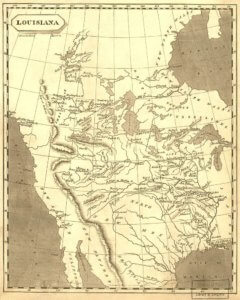
Document C
Matthew Karp, historian, Interview discussing his book, This Vast Southern Empire
Interviewer: When Americans talked about a “vast Southern empire” before the Civil War, what did they have in mind?
Matthew Karp: The short answer is that they weren’t talking about an independent Southern republic, but the entire United States.
It’s easy to find sectionalism in Southern politics before the Civil War, but the most powerful antebellum Southerners—from Andrew Jackson to Jefferson Davis—were nationalists, not separatists. What John C. Calhoun really wanted, as Richard Hofstadter wrote long ago, was not for Southerners to leave the Union but to dominate it, which they more or less did in the thirty years before the Civil War. Southerners imagined—and worked to build—an American republic whose foundation was slavery. In their minds, this was a powerful state, continental in scope and hemispheric in influence, which put the preservation of slaveholding property at the center of U.S. politics and U.S. foreign policy. That’s what they meant by “this vast Southern empire”…
What themes did you identify throughout these sources?
Some possibilities could include:
- The role of slavery in early territorial expansion and capitalism in later expansion
- The impact of expansion on who was included as American
- The relationship between expansion and democratic ideals
There are many more themes you could include! If you have any good ideas, write them in the comments section below. And happy studying!


